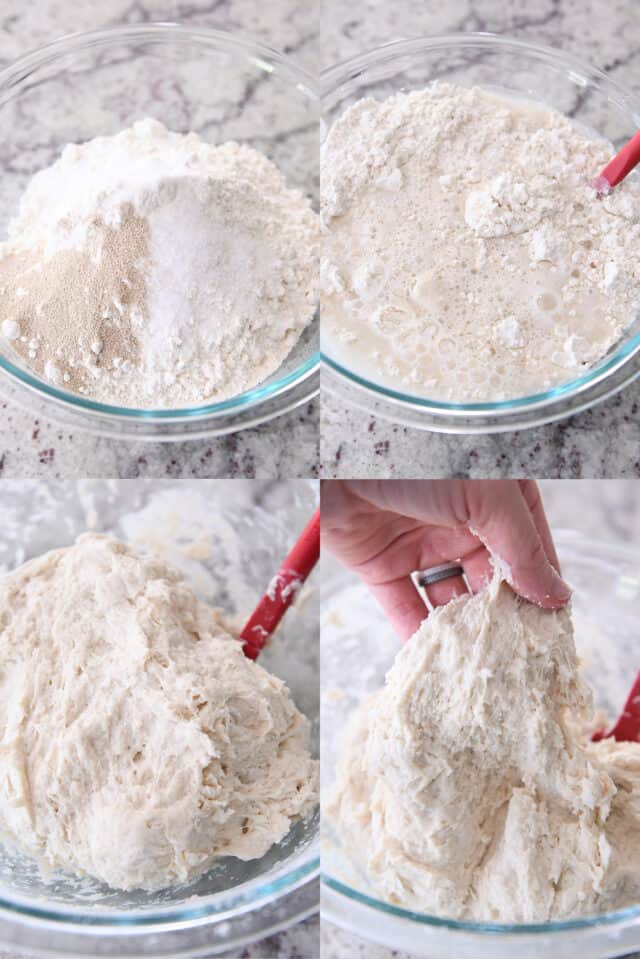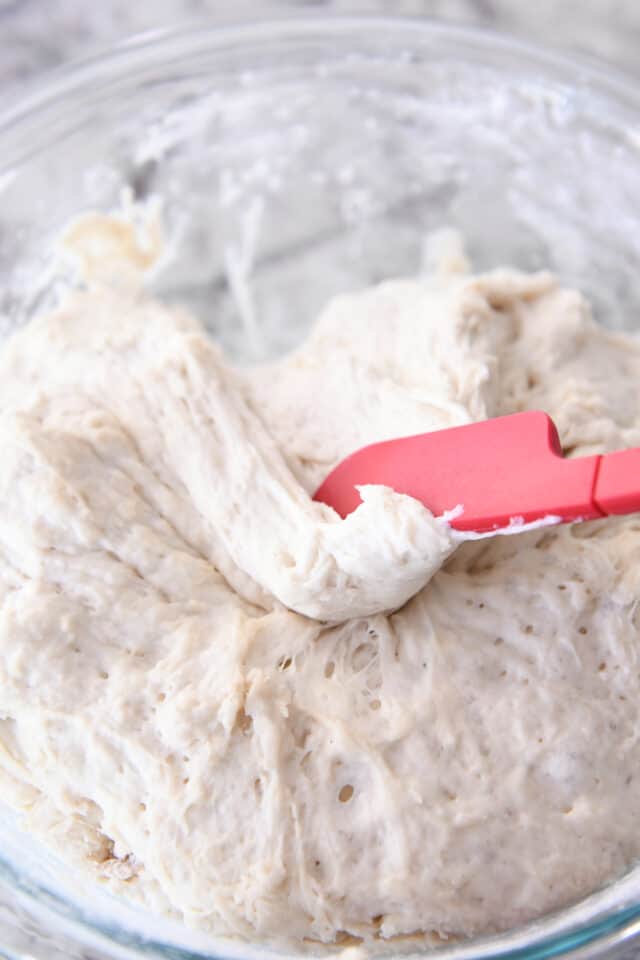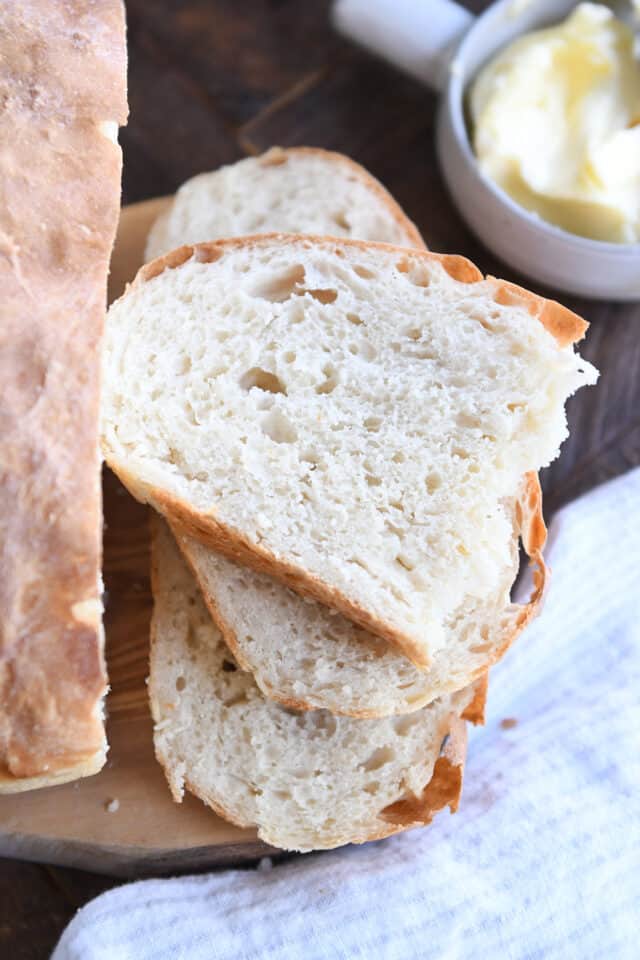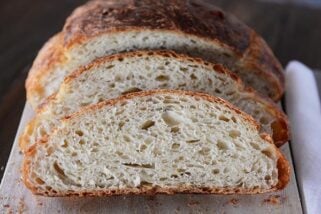Easy No-Knead Peasant Bread
This easy no-knead peasant bread is a game changer! Incredibly simple to make, it is soft, fluffy, and so delicious. We can’t stop making it!
I have been so excited to get this bread recipe in front of you. I’m not even exaggerating, not one little bit, when I say it has revolutionized homemade bread around here.
I’ve made it (easily) at least ten times in the last month. I’ve served it to company. Brought it to friends. Made it just because I wanted to eat homemade bread at 1:28 p.m. It is amazing.

No-Knead Bread is Not New
The no-knead bread trend is not new by any means. Wet, loose doughs formed into shaggy loaves and baked (most often) in a Dutch oven have been around a long time.
I have several recipes like that on my website already, like this artisan no-knead bread and this fantastic rustic crusty bread.
But this peasant bread is different and amazing enough to occupy its own spot here on the blog. For starters:
- it’s easier and a bit more straightforward than other no-knead bread recipes
- you don’t need a Dutch oven or baking stone for baking
- it can be baked in a variety of every day baking pans
- it doesn’t need long rising times
The crumb is soft and fluffy, and the crust is golden with just the perfect amount of bite and crustiness without cutting up the roof of your mouth.

How to Make Peasant Bread
In a large bowl, whisk together the flour, sugar, salt, and yeast. Add the water, and stir until no dry streaks remain.
It’s going to form a shaggy mass, and it’s going to be sticky. That’s exactly how you want it! Resist the urge to add more flour.

Grabbing a pinch of dough will leave a fair amount of sticky dough residue on your fingers.
Keeping the dough on the wet side of things is what allows us to skip any kneading and still end up with soft, fluffy bread.

Leave the dough right there in the bowl, cover the bowl, and let rise until doubled.
Once it is super puffy, grab a rubber spatula and start scraping the risen dough away from the sides of the bowl to form a messy ball in the center of the bowl.


How to Shape Soft Sticky Dough
Now for the fun part.
It can be a bit messy trying to shape soft, sticky dough like this into a loaf shape. A few tips:
- remember that it’s supposed to be kind of rustic, so ditch the idea of a perfectly shaped loaf
- grease your hands (cooking spray or oil); it makes a world of difference
- handle the dough quickly and efficiently – manhandling the dough will result in an epic dough bomb and lots of frustration
Here’s a quick video of how I shape this dough into a circle. I’m just lifting, rolling, and tucking a few times until it forms a pretty decent round shape.
Notice that my hands still end up with a bit of dough on them at the end. Feel free to use more cooking spray or oil, if needed. But don’t stress! It’s all part of the journey.
Best Pans to Use for Peasant Bread
The original peasant bread recipe calls for baking in oven-safe bowls (like Pyrex or others). Based on a traumatic experience in my past when my Pyrex bowls shattered coming out of the oven, I was determined to find a non-bowl solution for baking this bread.
I’m not saying you shouldn’t use a bowl for baking, I’m just letting you know I’ve come up with several fantastic alternatives that you probably already have in your kitchen.
After baking this bread in a Dutch oven, on a baking stone, in a round cake pan, and several other pan types, I’ve settled on the baking pan that works amazingly well and produces a loaf that is PERFECT.
A 9-inch pie plate.

The sides of the pie plate help stabilize the shape of the loaf as it rises and helps prevent the dough from spreading out and flattening.
The peasant bread bakes up beautifully in a 9-inch pie plate! It’s what I use 99% of the time when I bake this bread. And in case I haven’t made it abundantly clear: I have made this bread so.many.times. Like, you can really trust me on this one.

A metal pie plate works just fine, too. In fact, it actually gives a crustier exterior to the bread than a glass pie plate.
And, this bread bakes very well in a loaf pan, too. When shaping, go for more of a rectangle shape (but don’t over think it). Plop the loaf in a greased loaf pan, and get ready for some of the best bread of your life.

Best Bread Ever
I cannot overstate how amazing this easy, no knead peasant bread is. I want to beg, plead, bribe, force you to make it right this minute!
You’ll get all the rock star points for homemade bread with hardly any work. And you aren’t sacrificing anything in the name of it being an ultra-easy recipe. It is straight up some of the most delicious homemade bread ever.
I find myself turning to this bread recipe constantly now that I know it exists. It’s become our go-to bread for just about everything. Perfect for beginner and expert bread makers alike, please promise me you’ll make it soon!

One Year Ago: Mel’s Holiday Gift Guide: His + Hers
Two Years Ago: Perfect Homemade Caramel Apples
Three Years Ago: Perfect Small Batch Cinnamon Rolls
Four Years Ago: Easy Homemade French Bread
Five Years Ago: Harvest Pasta Sauce {Trader Joe’s Copycat}
Six Years Ago: Peanut Butter Cup Cheesecake with Chocolate Cookie Crust
Seven Years Ago: Gourmet Caramel Apples + Free Printable Handout
Eight Years Ago: Black Bean and Butternut Enchilada Skillet
Nine Years Ago: Peanut Butter Oatmeal Chocolate Chip Cookies
Ten Years Ago: Pumpkin Cookies with Caramel Frosting

Easy No-Knead Peasant Bread
Ingredients
- 4 cups (568 g) all-purpose flour (see note)
- 1 ½ teaspoons salt (see note)
- 2 teaspoons granulated sugar
- 1 tablespoon instant yeast (see note)
- 2 cups warm water
Instructions
- In a large bowl, add the flour, salt, sugar, and yeast. Whisk to combine. Add the water and mix with a rubber spatula or wooden spoon until the ingredients form a shaggy, sticky ball and no dry streaks remain.
- Cover the bowl and let the dough rise until doubled, about 1 to 1 1/2 hours.
- Place an oven rack in the center position. Preheat the oven to 425 degrees F. Generously grease a 9-inch pie plate or 8 1/2-by-4 1/2-inch loaf pan with cooking spray. (See note for other pan sizes/options.)
- Scrape the dough away from the sides of the bowl with a rubber spatula, forming a rough ball in the center of the bowl. Lightly grease your hands with cooking spray or oil and shape the dough into a circle loaf shape (or a rectangle loaf shape if using a loaf pan), tucking edges under. Place in the prepared pan. The loaf will not be completely smooth and may look a bit rough in shape, that's ok!
- Let the dough rest, uncovered, for 15-20 minutes until slightly puffy.
- Bake for 15 minutes. Reduce the heat to 375 degrees F and continue to bake for 15-20 minutes until golden.
Notes
Recommended Products
Recipe Source: adapted slightly from a recipe, Katherine B., a longtime reader sent me (thanks, Kat!) – originally from this recipe at Food52 and adding a link to Alexandra Stafford’s blog with lots of variations (I adapted it to use a pie plate or loaf pan for baking, and increased the flour and yeast amounts slightly)









What is the best way to store this bread? And how long can it be stored?
I let it cool completely and then store in a tightly closed bread bag. Because there isn’t any oil in the recipe, it’s best same day or the day after.
Hi Mel,
I normally made this recipe and it’s a huge hit – my husband loves it!
I was wondering whether the same results could be yielded from a bread maker? X
Hi Aimee, I don’t own a bread maker and thus have never tried this recipe in a bread maker machine. Sorry I’m not more help!
Hi Mel! I recently got some soft white multipurpose flour to see if my gut can handle this type of wheat flour. I’m desperate to try some brea! Would that type of flour work in this recipe? Or do you have a different bread recipe that it might work with?
Thank you!
Hi Sarah – is it gluten-free flour or regular all-purpose (gluten/wheat) flour?
It is not gluten free flour. It is a French flour I bought made with soft white wheat.
I think it definitely stands a chance of working in this recipe if it is a gluten/wheat based flour.
Best recipe ever! Every time I make this my boys devour it and if I take it anywhere I’m always giving out the recipe! Thank you Mel for always making me look good😉😊
Thanks, Shelby!! Take all that credit for yourself! (I hope your boys know how lucky they are to get homemade bread!) 🙂
Only reason I’m rating it a 3 is because it didn’t turn out right and the directions mention nothing about what happens to the bread after you pull it out of the oven…how do you know when it’s done? Do you let it cool before slicing it? This is the first time I’ve EVER baked my own bread. Followed the recipe to the “letter” even the exchange for active dry yeast (subtracting 1/4 cup from the overall warm water added to your flour mixture). And when the timer went off after the longest amount of time and the outside was golden brown, I sliced into that bad-boy excited for dinner, only to see that the inside was still really uncooked and gooey. I put it back in the oven (obviously missing the slice I cut into for dinner) and baked it for another 15 mins hoping it would bake through. I tented it as not to burn the golden outside, but because I interrupted the baking process the bread was ruined and unable to be redeemed. I’d love to try to make it again, but would really love to know what I did wrong and how it could be avoided. Updating the directions to include some of this might be helpful for the next newcomer vs you bake for this long, pull it out, done (when the rest of the directions were totally specific). I stuck to eating the outside layer, as not to let it go to waste. Guess better luck next time.
I’ve found that you need to let it cool so it’s not gooey inside. I usually shoot for 30 minutes. It sounds like yours was done (golden brown on the outside), it just needed to cool.
I’m glad you gave this a try! I’ll look at adding a few more details to the recipe, but this bread does benefit from being cooled before slicing into. The texture will greatly improve (fluffy and not gummy).
Made this for a recipe club girls night this past weekend! It was incredibly simple to make and absolutely delicious. Bread has always intimidated me but this recipe is fool proof. It was delicious on its own but also made a turkey panini sandwich with it and YUM!!